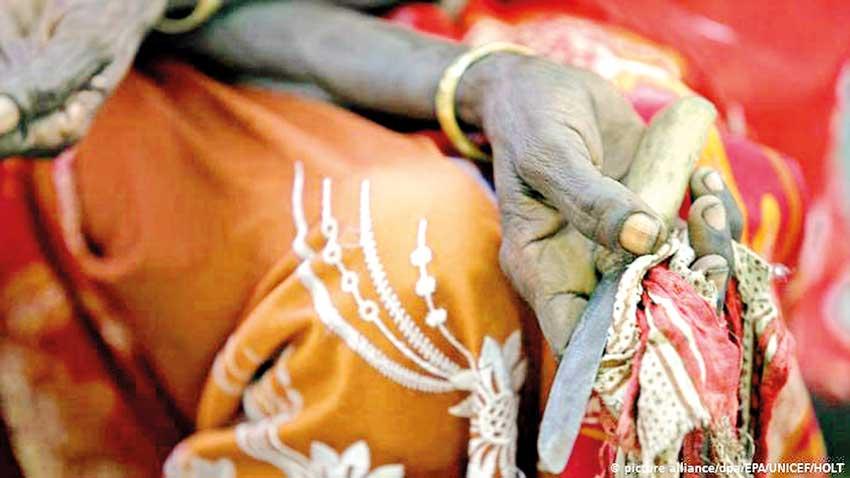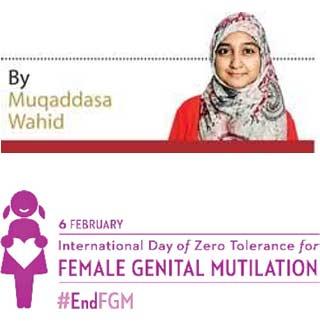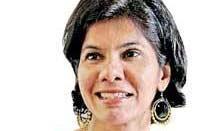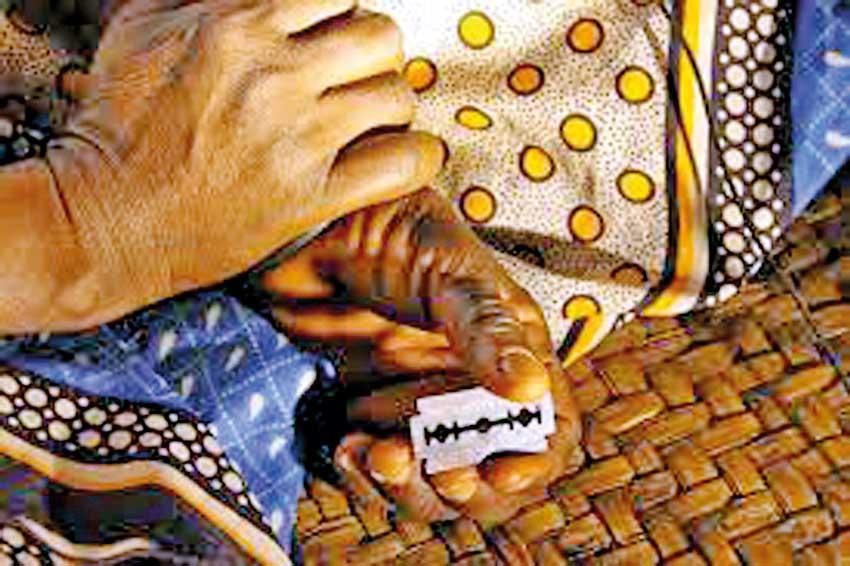Reply To:
Name - Reply Comment

On the 40th day after birth a woman known as ‘Ostha Maami’ is called to the house of the infant to make a small cut on the genital area
Many who practise this think it is a part of the religion, but when questioned where in the religion it is stated so, they do not know
Some sections of the community believe that the practice enables girls to have control over their sexual desires
It is believed that when a girl has undergone this practice, the girl is quiet, demure and calm
The practice of FGM/C has not been stated in any of the Islamic religious texts and has been misinterpreted by proponents of FGM/C.
Saroor dismisses claims that it is a religious practice stating that it was a cultural practice which had no basis in the religion and was a tool by the patriarchal society to oppress women
 When one thinks of FGM/C (Female Genital Mutilation/ Cutting), many think it is only prevalent in the African region. However, recent media reports and research show that the practice also prevails in Sri Lanka, especially among certain sects of the Muslim community and the Dawoodi Bohra community, around the island. The earliest available report of FGM/C in the country dates back to 1996. The World Health Organisation (WHO) estimates that over 200 million girls and ladies have been subjected to the practice in the African, Middle Eastern and Asian regions. According to the WHO, FGM/C is defined as ‘procedures that involve partial or total removal of the external female genitalia, or other injury to the female genital organs for non-medical reasons.’
When one thinks of FGM/C (Female Genital Mutilation/ Cutting), many think it is only prevalent in the African region. However, recent media reports and research show that the practice also prevails in Sri Lanka, especially among certain sects of the Muslim community and the Dawoodi Bohra community, around the island. The earliest available report of FGM/C in the country dates back to 1996. The World Health Organisation (WHO) estimates that over 200 million girls and ladies have been subjected to the practice in the African, Middle Eastern and Asian regions. According to the WHO, FGM/C is defined as ‘procedures that involve partial or total removal of the external female genitalia, or other injury to the female genital organs for non-medical reasons.’
Type 1- Partial/ total removal of the external visible part of the clitoris (clitoral glans) and/or the prepuce/clitoral hood.
Type 2- Partial/total removal of the clitoral glans and labia minora with/without removal of the labia majora.
Type 3- narrowing of the vaginal opening through the creation of a seal. The seal is formed by cutting and repositioning of the labia minora/labia majora, sometimes through stitching, with/without removal of the prepuce/clitoral hood and glans.
Type 4- includes all other harmful procedures to the female genitalia for non-medical purposes, such as pricking, piercing, incising, scraping and cauterising the genital area.
According to a study conducted by the Family Planning Association of Sri Lanka (FPA), Type 1 and Type 4 are the methods of FGM/C that takes place in the country. “Within the Muslim community, it is usually done on the 40th day of the birth, but among the Dawoodi Bohra community, I’ve heard that it occurs when the child is seven years old,” said Shreen Saroor, a Human Rights Activist. Saroor also noted that adult females, who have converted, have also had to go through the practice. Speaking to Daily Mirror, Khair*, a grassroots level volunteer stated that many women had no knowledge of themselves being subjected to the practice until their female infants were subjected to the practice. “Many women knew of the existence of FGM/C the day their mothers or elderly women in the family would inform them that their infant daughters have to be subjected to this practice on the 40th day of after birth,” she said, noting that the male members in the family had no knowledge of the practice as the procedure was done secretly and discreetly.
Describing about the procedure, Khair stated that on the 40th day after birth, a woman known as ‘Ostha Maami’ is called to the house of the infant to shave the head of the infant and also conduct FGM/C. “Usually the mother does not see the procedure. The elderly women in the family give the mother something to do and she walks out of the room. As soon as she walks out of the room, the Ostha Maami uses a small knife or new razor and makes a small cut on the genital area. Then a cotton wool with eau-de-cologne or turmeric is dabbed on the area. Sometimes talcum powder is used. This is done very quickly, before the mother walks into the room,” described Khair, adding that in some instances extreme bleeding has been reported and thus medical intervention would be necessary at such an instance. The description of this practice conforms to the definition of Type 4. Khair also noted that those who had not undergone the practice as babies and instead undergone this later in life, recall the practice clearly and for some, it had been traumatic.
Saroor shared that Ostha Maamis were mostly old women who carried this as a family business, where the practice was shared across generations. “The practice has been there for a long time. After 1990, even when the practice was questioned, it did not stop. Instead it got more professionalised. Some doctors performed it for money and some private hospitals accommodated it as part of a profitable activity,” added Saroor.
 The practice has been there for a long time. After 1990, even when the practice was questioned, it did not stop. Instead it got more professionalised. Some doctors performed it for money and some private hospitals accommodated it as part of a profitable activity
The practice has been there for a long time. After 1990, even when the practice was questioned, it did not stop. Instead it got more professionalised. Some doctors performed it for money and some private hospitals accommodated it as part of a profitable activity
Shreen Saroor - Human Rights Activist
Is this a religious practice?
“Many who practise this think it is a part of the religion, but when questioned where in the religion it is stated so, they do not know. From my experience, most women carry this out, at the behest of their mothers, mothers-in-law and elderly women in the family,” she said noting that many of the younger generation are opposing the practice. Khair also revealed that the practice does not take place in some Muslim- majority countries and many Sri Lankans who were born in such countries had not had FGM/C practised on them. She stated that the community belief is that the practice enables girls to have control over their sexual desires. “It is believed that when a girl has undergone this practice, the girl is quiet, demure and calm. It is a common belief that girls who don’t undergo this act like tomboys and have no control over sexual feelings. When girls elope in the community, people think that the FGM/C has not been carried out properly or it has not been done on them,” she said adding that practice is also believed to supposedly aid in keeping the genital area clean and hygienic.
Saroor dismissed claims that it is a religious practice stating that it was a cultural practice which had no basis in the religion and was a tool by the patriarchal society to oppress women.
The FPA report stated that certain sects of the Muslim community did not practice this because they believe there is no religious basis in the practice. A report ‘De-linking FGM/C from Islam’ by Ibrahim Lethome Asmani and Maryam Sheikh Abdi points out that the practice of FGM/C has not been stated in any of the Islamic religious texts and has been misinterpreted by proponents of FGM/C. Furthermore, the report goes on to show that the religious texts used to support FGM/C as a religious practice by the supporters of FGM/C have been dismissed by scholars as invalid or fabricated. However, in 2008, the All Ceylon Jamiyyathul Ulama (ACJU) issued a fatwa (legal pronouncement) stating that ‘female circumcision is obligatory and recommended’ citing religious teachings as well as the view that circumcision is important to maintain cleanliness of the genitals and ‘for enjoyment in family life’.
Speaking to Daily Mirror, Prof. Hemantha Senanayake, Professor of Obstetrics and Gynaecology noted that in some cases of FGM/C there could be significant scarring but, in many cases, the scars aren’t noticeable or have healed up. “Sometimes, when women who have undergone severe forms of FGM/C come for delivery, their delivery can be very challenging due to removal of some parts of the genitalia,” he said. He noted that mostly minor forms of FGM/C were carried out in Sri Lanka in comparison to the FGM/C practiced in African countries.
A journal article in the Ceylon Medical Journal by Wickramage et al (2018), in which the research panel also included Dr Lakshmen Senanayake, former President of the Sri Lanka College of Obstetricians and Gynaecologists, points out the consequences to the physical and mental health of women as a result of FGM/C. Formation of scar tissue, keloids and Bartholin cysts on the vulva, damage to the reproductive, urinary and gastrointestinal tracts, increased susceptibility to sexually transmitted diseases, pain and reduced pleasure during sexual intercourse, infertility are some of the physical health implications expressed in the article. It also points out that traumatic memories of the practice have been shown to result in post- traumatic stress disorder, relationship issues and lowering of self-esteem in girls and women.
In the FPA report, it is seen that FGM/C was not part of the training process carried out for doctors in Sri Lanka and that some doctors have been exposed to it while working and/or training in the UK. It was also revealed that medical professionals were unaware of the practice occurring in the country and due to the lack of training, they had not looked for signs of FGM/C during their work. They were also of the consensus that it might be difficult to view any physical sign of the practice unless a significant removal of any part of the genitalia has been done.
 Sometimes, when women who have undergone severe forms of FGM/C come for delivery, their delivery can be very challenging due to removal of some parts of the genitalia
Sometimes, when women who have undergone severe forms of FGM/C come for delivery, their delivery can be very challenging due to removal of some parts of the genitalia
Prof. Hemantha Senanayake -
Professor of Obstetrics and Gynaecology
Despite being party to the Convention on the Elimination of All Forms of Discrimination against Women (CEDAW) and ratifying the Convention on the Rights of the Child, Sri Lanka is yet to criminalise FGM/C. Though a circular was issued by the Health Ministry in 2018, prohibiting medical practitioners from carrying out FGM/C, Saroor pointed out that it was mostly Ostha Maamis who carried out FGM/C rather than medical professionals. “This circular had very little impact on the practice of FGM/C. The state is responsible to protect its citizens therefore it has to step up and make FGM/C illegal through law,” called out Saroor.
Khair also noted that there should be an increased awareness of this issue in the community. “This is a very sensitive issue, hence we cannot jump into action immediately. The community should be made to understand the negative impacts of the practice. For this, discussion on FGM/C should be encouraged in the community,” she said adding that anti-FGM/C activists are often seen in a negative light in the community.
Ermiza Tegal, an Attorney-at-Law and one of the authors of the FPA report stated that the practice is a clear violation of child rights. She also revealed that during the course of the research, she had realised that there were knowledge gaps and contradictions regarding this practice in the country. “One of the key concerns that came out of the study is that women should not feel marginalised in this discussion. Women should have all the information and make informed decisions without harming the children,” she said adding that the state and medical community must provide support and knowledge for women to take informed decisions on such practices. “One must be careful not to use this issue to ostracise, demonise or vilify a community or an identity. This is particularly important given the current Sri Lankan context of intolerance. It is abundantly clear that women’s views on this issue were informed by patriarchal discourses. This phenomenon is not unique to any one particular community in this country. The discourse and practice of failure to obtain consent, coercion, violence and control over female sexual pleasure are themes that can be identified in relation to this practice as well,” she emphasised.
Testimonials from women who have undergone FGM/C have been submitted to the Human Rights Commission, Parliamentary Sectoral Oversight Committee on Women and Gender, National Child Protection Authority and a proposal to ban the practice was submitted in 2017 to the then Justice Minister, Thalatha Atukorale. Other than the circular issued in 2018, no further action has been taken yet. The question remains whether banning FGM/C would completely halt the practice or make it go underground.
“I believe it would not be difficult to stop this gruesome practice. I think what needs to happen first of all is for the laws and the reasons behind them to be made known to the people affected. They need to hear in their own language, why FGM is bad- that it is both a cruel and medically high- risk practice- and that it is illegal. Secondly, support for the women who are affected is desperately needed. Thirdly- and most contentiously- we need vigilance. I think doctors should examine girls when they are very small, and check them again every year. Doctors, midwives and nurses check children for other health issues, and this is a health issue. Finally, the law must be enforced, and people suspected of being involved in carrying out this practice should be taken to court,” – Waris Dirie, former UN special ambassador against FGM.
*Names have been changed to protect identity
 One of the key concerns that came out of the study is that women should not feel marginalised in this discussion. Women should have all the information and make informed decisions without harming the children
One of the key concerns that came out of the study is that women should not feel marginalised in this discussion. Women should have all the information and make informed decisions without harming the children
Ermiza Tegal
An Attorney- at- Law
